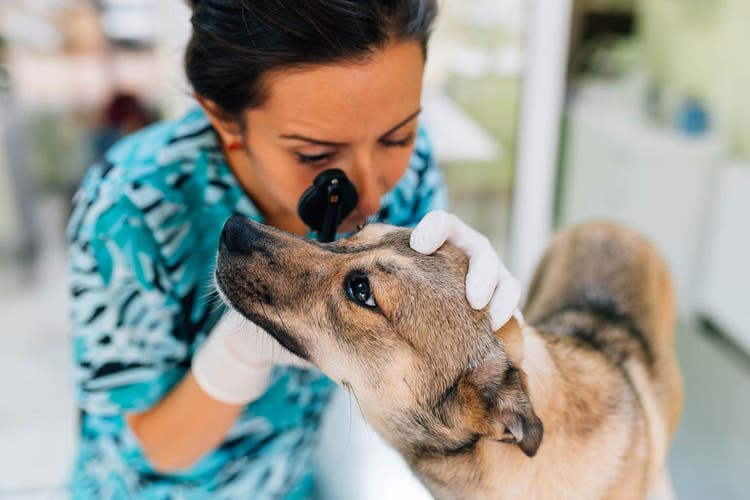
Dog Exams: You Should be Taking Your Pup Every Six Months
Keeping your dog healthy is critical for a long happy healthy life. One of the best ways to do this is to provide routine dog exams.
What is a dog exam? Most people think of a dog exam as an examination by a licensed veterinarian. However, it is also possible to do a dog exam at home. Below we will describe and explain what is involved in a dog exam with your vet as well as give you tips on how you can do a dog exam at home.
Veterinary Dog Exams
An “exam” most commonly refers to a “physical examination” by a veterinarian. This involves the veterinarian evaluating the general appearance of the dog looking at the skin and coat, in the eyes, in the ears, in the mouth, listening to the heart and lungs with a stethoscope (also referred to as auscultation), feeling specific areas of the body such as the legs, joints and abdomen (referred to as palpation), and evaluating the overall attitude and demeanor of the dog.
The goal of the examination is to look for physical or behavioral abnormalities that can impact the health and wellbeing of the dog. Early diagnosis and treatment can improve outcomes.
What Does a Veterinary Dog Exam Cost?
The cost of a dog exam is generally included with the basic appointment fee and can vary depending on your location in the country, the particular veterinary clinic, and the type of appointment you are seeking. A recheck exam, a follow-up appointment to review the same problem seen before, is often less expensive.
An appointment with a general practice veterinarian will generally less expensive than an evaluation at an emergency clinic or by a board-certified veterinary specialist. There is often a range in costs with the average cost $42 to $65 for a general practice veterinarian, $90 to $225 for an emergency dog exam or a veterinary specialist dog exam.
Diagnostics tests and treatments are an additional cost. Your veterinary team should give you an estimate for any additional costs.
Why Are Dog Exams Important?
Dog exams are important. Dogs age quickly and are unable to communicate their problems. In fact, dogs age about 5 to 10 years for every year we age. A lot can change in that time. That is why it is important to have routine dog exams.
Your veterinarian has special training and experience to detect problems that you may not even realize that your pet has. They can detect cataracts, painful dental problems, ear infections, skin infections or parasites, heart murmurs, abnormal lung sounds, feel tumors, abnormal joints, ligament tears, or abnormal organ shapes or sizes. They can also guide you about your dog’s body condition relative to the ideal such as if your dog is too fat or too thin which can optimize your dog’s health and wellbeing.
Dogs can be ill and you may not realize it. Routine exams and blood work can detect significant and even life-threatening problems. Early diagnosis can be critical to successful treatment.
How Often Should You Have a Veterinary Dog Exam?
The ideal frequency for a dog exam depends on your dog’s age and underlying health issues. A young healthy dog from ages one to seven may only need yearly examinations.
However, older dogs should have more frequent exams. It is common for pet owners to attribute issues such as slower to get up, less playful, or sleeping more to a dog getting older when instead there is a treatable problem that can make your dog feel better and live longer. This makes dog exams very important in older dogs. Older dogs and dogs with underlying health problems need dog exams more frequently. Large breed dogs over the age of 7 and small breed dogs over the age of 10 may benefit from exams every 6 months.
How Can You Do a Dog Exam at Home?
It is possible to examine your dog at home. Your dog cannot explain his symptoms, so it’s the responsibility of you and your veterinarian to take care of him. If you don’t or can’t take your dog to your vet for an exam, there are some questions you can answer at home and things to look for when you look at every part of his body to help you do a dog exam at home. Learn How to Examine Your Dog at Home.
Other things you can do at home to keep your dog healthy are to promote and optimize wellness. How to Promote Dog Wellness It is also important to spend time with your dog and Why It’s Important to Spend Time With Your Dog and keep your dog groomed on a regular basis. Why Grooming Your Dog is So Important.
Additional Articles that May be of Interest About Dog Exams:
- How to Promote Dog Wellness
- Why Grooming Your Dog is So Important
- Why It’s Important to Spend Time With Your Dog
- Keeping Your Dog Healthy: Year-Round Parasite Prevention for Dogs
- Choking in Dogs
- The # 1 Dog Emergency Seen in Emergency Rooms
- Diarrhea is the 2nd Most Common Dog ER Visit – What You Should Know
- Not Eating: Third Most common Dog ER Visit & What You Should Know
- How Much Should You Expect For Dog Vet Costs?
- What is Pet Insurance?
- How Does Pet Insurance Work?
- Questions To Ask When Choosing A New Vet